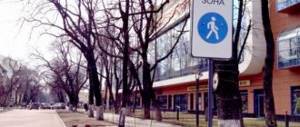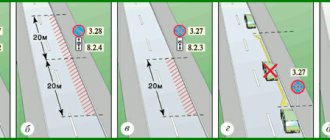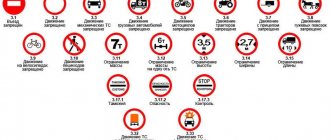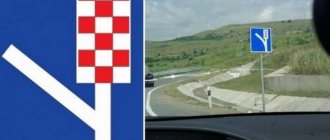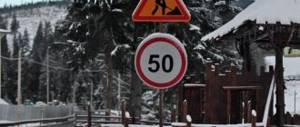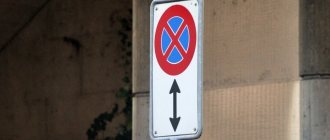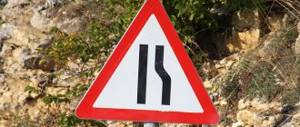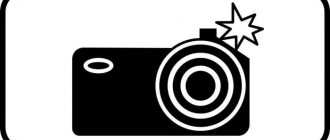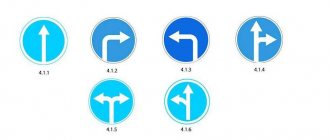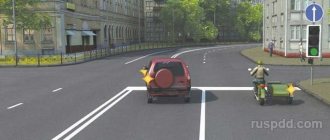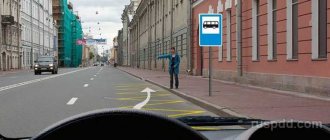Sign 3.13 “Height limitation”
Road sign 3.13 “Height limit” is used to prohibit the movement of vehicles whose overall height (laden or unladen) is greater than that indicated on the sign.
The sign is installed in cases where the distance from the road surface to the bottom of the span of an artificial structure, utilities, gates, etc. (span height) less than 5 meters.
The height indicated on the sign is 0.2 - 0.4 meters less than the actual height. These are the norms. Moreover, this difference between the actual height and the height indicated on the sign can be increased depending on the evenness of the road surface (the number on the sign is slightly less than the actual span height).
If the height of the vehicle (with or without a load) is greater than indicated on the sign, then the driver must drive around the road section along a different route. To warn the driver about the vehicle height restriction ahead, sign 3.13 is duplicated, i.e. are also pre-installed.
Preliminary sign 3.13 “Height limit” with plate 8.1.1 “Distance to object” is installed behind the intersection at the beginning of the road section on which vehicle height restrictions are introduced. Accordingly, at this intersection it is possible to choose a different route.
Repeated sign 3.13 (main) is installed directly at the place of restriction. It is allowed to install a sign on the span of an artificial structure, and if there is a large gate in front of it, on the gate.
The yellow background of sign 3.13 “Height limitation” means that the sign is temporary.
Penalty for violating sign 3.13 “Height limit”
For failure to comply with the requirements of sign 3.13 “Height Limitation,” sanctions may be imposed on the driver in the form of a warning or a fine of 500 rubles under Part 1 of Article 12.16 of the Administrative Code.
If an attempt to pass under the “Height Restriction” sign resulted in undesirable consequences for the span, cargo or vehicle in the form of damage, i.e. caused an accident, then the sanctions will be different.
Responsibility for the driver for violating the permissible dimensions of the vehicle when transporting cargo is determined by parts 1-6 of Article 12.21.1 of the Administrative Code. The “range” of fines varies from the degree of violation of the rules for transporting goods from 1 to 10 thousand rubles per driver, with the detention of the vehicle.
Fines for non-compliance with the rules
From all the information presented earlier, a conclusion can be drawn, the key points of which are shown in the image:
Any failure to comply with these requirements may cause an emergency resulting in injury to people or their property.
If we consider the situation regarding administrative offenses, the legislation provides for various options for the development of events:
- Code of Administrative Offenses of the Russian Federation Art. 12.21 clause 1 - failure to comply with transportation conditions with a fine of 500 rubles .
- Code of Administrative Offenses of the Russian Federation Art. 12.21.1, clarifying the excess of the permissible dimensions given in the documents by different amounts depending on the specific item. Large permissible vehicle weight by a different amount without a permit or exceeding the weight specified therein or the axle load on each axle by an amount corresponding to a specific section.
According to 11 paragraphs of this article, the punishment for the following persons is characterized:
- physical (driver);
- legal (organizations, enterprises and other companies, regardless of their legal regulation);
- officials who committed a violation while performing their duties under the employment contract;
- individual entrepreneurs transporting cargo with deviations from specified parameters.
Art. 12.21.1 of the Code of Administrative Offenses of the Russian Federation regulates various deviations from regulatory conditions regarding the overall parameters of a vehicle transporting cargo and moving empty. The penalty is provided in accordance with the degree of difference determined by the content of 11 points.
It should be noted that, with the exception of paragraph 10 of this article, liability for offenses of individual entrepreneurs is equal to legal entities.
Based on the information presented, it becomes obvious that a simple trip to the country with seedlings sticking out of the window of a car can cause close attention from traffic police officers and result in a fine.
A similar situation can happen with trucks transporting large cargo. Avoiding an unpleasant situation is not so difficult - just carefully read the requirements of Russian legislation and carefully comply with them.
Sign 3.14 “Width limitation”
Road sign 3.14 “Width limitation” is used to prohibit the movement of vehicles whose overall width (laden or unladen) is greater than that indicated on the sign.
The sign is installed in front of the passage if its width is less than 3.5 meters (for example, in a tunnel, between bridge supports and in other narrow places). The width indicated on the sign is 0.2 meters less than the actual width. These are the rules.
If the width of the car (with or without a load) is greater than on the sign, then the driver must go around this section of the road along a different route. To warn the driver about the existing vehicle width restriction ahead, sign 3.14 is installed twice, i.e. there will be a preliminary sign first.
Preliminary sign 3.14 “Width limitation” with plate 8.1.1 “Distance to object” is installed behind the intersection at the beginning of the road section on which vehicle width restrictions are introduced. At this intersection, the driver can change his route and choose a different direction.
Repeated sign 3.14 (main) is installed directly at the place of restriction. It is allowed to install a sign on a span or support of an artificial structure.
The yellow background of sign 3.14 “Width limitation” means that the sign is temporary.
How to install?
The sign regarding height restrictions has the form of a prohibition and is installed on the ground. It is worth considering that the installation work for installing this sign is carried out before the coverage area of the sign in question begins. The placement of the height vector, as an example, can be fixed as 3.5 meters. It depends on what maximum size is envisaged by the design as possible. The height that must be taken into account is the distance from the pedestrian crossing or other area on the road floor to the edge of the building. In this case, the lower edge is taken into account. The location of the sea does not matter in this case.
According to the established GOST, a small reserve distance is established relative to the value under consideration. Photos of symbols in this situation are not included in the legislative provisions. However, legislators indicate that for such buildings as overpasses and bridges the height will be approximately twenty cm less, while for various types of overpasses this distance becomes less than about 40 cm. The specified centimeters are subtracted from the height that is permissible by law. Provisions are made according to which escape or fire routes may be laid at a given distance in the future.
The designation of this sign applies only to freight transport.
In particular, it is indicated:
- The sign to some extent repeats the legal provisions. They affect the rules of vertical marking.
- Such markings are applied to structures that have a side or top character.
In order for the sign to be visible in the dark, its design will be depicted using paint that has reflective properties. Evacuation, even from a familiar site, is carried out in accordance with detour signs. Garages also have height restrictions in some situations. Aircraft flights may also affect de-watering positions, which indicates the impossibility of lowering aircraft to a certain level.
The construction of the buildings in question is carried out at the level prescribed by law. If the sign is applied to a yellow background, this indicates that it is temporary. When there are discrepancies between permanent signs and temporary ones, you need to follow the information reflected in the latter.
Penalty for violating sign 3.14 “Width limitation”
For failure to comply with the requirements of sign 3.14 “Width Limitation,” sanctions may be imposed on the driver in the form of a warning or a fine of 500 rubles under Part 1 of Article 12.16 of the Administrative Code.
If an attempt to drive under the “Width Restriction” sign resulted in undesirable consequences for the structure of the span, cargo or vehicle in the form of damage, in other words, became the cause of an accident, then the sanctions will be different, based on the results of the investigation.
Responsibility for the driver for violating the permissible dimensions of the vehicle when transporting cargo is determined by parts 1-6 of Article 12.21.1 of the Administrative Code. The “range” of fines varies from the degree of violation of the rules for transporting goods from 1 to 10 thousand rubles per driver, with the detention of the vehicle.
Fines
For failure to comply with the requirements of sign 3.13, the driver is subject to administrative liability, in accordance with Part 1 of Article 12.16 of the Code of Administrative Offenses of the Russian Federation. The violator must pay a fine of 500 rubles.
The driver of a heavy vehicle may be stopped by traffic police officers to check compliance with the permissible dimensions. If the dimensions exceed the norm, a fine will be imposed on the driver, in accordance with Article 12.21.1 of the Code of Administrative Offenses of the Russian Federation.
Violation of the above prohibitions is extremely dangerous to life: if the car body damages the supporting structures of technical structures, they may collapse.
Sign 3.15 “Length limitation”
Road sign 3.15 “Length limitation” prohibits the movement of vehicles (or combinations of vehicles) whose overall length (with or without load) is greater than that indicated on the sign.
The “Length Limitation” sign is used to prohibit the movement of the above vehicles on sections of roads with narrow carriageways, close buildings, sharp turns, etc., where their movement or passing with oncoming vehicles is difficult.
If the overall length of a car or vehicle combination (with or without cargo) is greater than that indicated on the sign, then the driver must go around this section of the road along a different route. To warn the driver about the restriction on the length of the vehicle ahead, sign 3.15 is installed twice, i.e. there will be a preliminary sign first.
Preliminary sign 3.15 “Length limitation” with plate 8.1.1 “Distance to object” is installed behind the intersection at the beginning of the road section on which vehicle length restrictions are introduced. At this intersection, the driver can change his route and choose a different direction.
Repeated sign 3.15 (main) is installed directly at the beginning of the restriction.
The yellow background of sign 3.15 “Length limitation” means that the sign is temporary.
Penalty for violating sign 3.15 “Length limitation”
For failure to comply with the requirements of sign 3.15 “Length Limitation”, the driver may be subject to sanctions in the form of a warning or a fine of 500 rubles under Part 1 of Article 12.16 of the Administrative Code.
If an attempt to drive under the “Length Limit” sign resulted in undesirable consequences for the structure of the passage, cargo or vehicle in the form of damage, i.e. caused an accident, then the sanctions will be different based on the results of the investigation.
Responsibility for the driver for violating the permissible dimensions of the vehicle when transporting cargo is determined by parts 1-6 of Article 12.21.1 of the Administrative Code. The “range” of fines varies from the degree of violation of the rules for transporting goods from 1 to 10 thousand rubles per driver, with the detention of the vehicle.
Sign 3.16 “Minimum distance limitation”
Road sign 3.16 “Minimum distance limitation” is used to prohibit the movement of vehicles with a distance between them less than that indicated on the sign. Sign 3.16 can be found on bridge structures with spans of limited load capacity, on ice crossings, in tunnels, etc.).
The effect of sign 3.16 extends from the place where the sign is installed to the nearest intersection behind the sign, and in a populated area, if there is no intersection, to the end of the populated area.
If necessary, the coverage area of sign 3.16 can be reduced by using plate 8.2.1 “Validity area”.
The yellow background of sign 3.16 “Minimum distance limitation” means that the sign is temporary.
Weight limit sign
A weight limit sign prohibits the movement of vehicles whose actual weight exceeds the weight on the sign:
In this case, the movement of vehicles weighing more than 7000 kg is prohibited. Naturally, this restriction does not apply to passenger cars B.
This sign is installed, for example, in front of bridges to take into account their load capacity and prevent overload. The sign is also installed before ice crossings. Violation of its requirements can be very dangerous, because can lead to the destruction of the crossing and immersion of the car under water.
Penalty for violating sign 3.16 “Minimum distance limit”
For failure to comply with the requirements of sign 3.16 “Minimum distance limitation,” the driver may be subject to sanctions in the form of a warning or a fine of 500 rubles. in accordance with Part 1 of Article 12.16 of the Administrative Code.
The fine for violating sign 3.16 should not be confused with the fine for, so to speak, general failure to maintain the distance in which an accident occurs (a rear-end collision). Failure to keep the distance is interpreted as a violation of the location of the vehicle on the roadway, and is punishable under Art. 12.15 part 1 - fine 1500 rubles.
In the case of sign 3.16, sanctions will follow for violating the minimum established distance.
A complete list of prohibitory road signs with brief comments (explanations) on the website is posted in Appendix 1 of the Traffic Regulations.
Navigation through a series of articles<< Prohibitory signs 3.11-3.12 “Weight limit” Prohibitory road signs 3.17.1-3.17.3 >>
